|
| |
Archives
bin laden
FBI says, it has “No hard evidence connecting Bin Laden to 9/11”
|
This past weekend, a thought provoking e-mail circulated through Internet news groups, and was sent to the Muckraker Report by Mr. Paul V. Sheridan (Winner of the 2005 Civil Justice Foundation Award), bringing attention to the FBI’s Most Wanted Terrorist web page for Usama Bin Laden.[1] (See bottom of this web page for Most Wanted page) In the e-mail, the question is asked, “Why doesn’t Usama Bin Laden’s Most Wanted poster make any direct connection with the events of September 11, 2001?” The FBI says on its Bin Laden web page that Usama Bin Laden is wanted in connection with the August 7, 1998 bombings of the United States Embassies in Dar es Salaam, Tanzania, and Nairobi, Kenya. According to the FBI, these attacks killed over 200 people. The FBI concludes its reason for “wanting” Bin Laden by saying, “In addition, Bin Laden is a suspect in other terrorists attacks throughout the world.”
On June 5, 2006, the Muckraker Report contacted the FBI Headquarters, (202) 324-3000, to learn why Bin Laden’s Most Wanted poster did not indicate that Usama was also wanted in connection with 9/11. The Muckraker Report spoke with Rex Tomb, Chief of Investigative Publicity for the FBI. When asked why there is no mention of 9/11 on Bin Laden’s Most Wanted web page, Tomb said, “The reason why 9/11 is not mentioned on Usama Bin Laden’s Most Wanted page is because the FBI has no hard evidence connecting Bin Laden to 9/11.”
| |
[more]
So why, pray tell, did we invade Afghanistan?
book recommendation
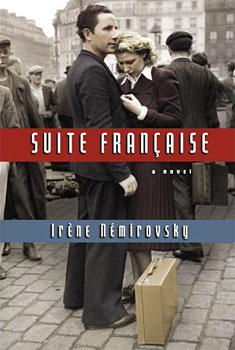
Suite Francaise
by Irene Nemirovsky
From Amazon:
|
Celebrated in pre-WWII France for her bestselling fiction, the Jewish Russian-born Némirovsky was shipped to Auschwitz in the summer of 1942, months after this long-lost masterwork was composed. Némirovsky, a convert to Catholicism, began a planned five-novel cycle as Nazi forces overran northern France in 1940. This gripping "suite," collecting the first two unpolished but wondrously literary sections of a work cut short, have surfaced more than six decades after her death. The first, "Storm in June," chronicles the connecting lives of a disparate clutch of Parisians, among them a snobbish author, a venal banker, a noble priest shepherding churlish orphans, a foppish aesthete and a loving lower-class couple, all fleeing city comforts for the chaotic countryside, mere hours ahead of the advancing Germans. The second, "Dolce," set in 1941 in a farming village under German occupation, tells how peasant farmers, their pretty daughters and petit bourgeois collaborationists coexisted with their Nazi rulers. In a workbook entry penned just weeks before her arrest, Némirovsky noted that her goal was to describe "daily life, the emotional life and especially the comedy it provides." This heroic work does just that, by focusing—with compassion and clarity—on individual human dramas.
| |
[more]
This is an amazing book. Actually, 2/5 of a book. It was written in the middle of the occupation but the author died in a concentration camp before it could be completed. Truly amazing. It makes an interesting companion piece to The War by Marguerite Duras.
Emigré Jew's wartime book takes France by storm
|
Sixty-two years after its author died in the gas chambers of Auschwitz, a remarkable and previously unpublished wartime work by an emigré Russian Jew in France has taken the world of publishing by storm.
Suite francaise, the first two parts of what Irène Némirovsky originally intended to be a five-volume epic, has been hailed by ecstatic French critics as "a masterpiece" and "probably the definitive novel of our nation in the second world war".
| |
[more]
iraq
The Zarqawi effect
Bush's Mideast policies have turned a brutal terrorist into an icon of resistance -- and made violent fundamentalism more popular.
|
Whatever the meaning of the killing of Jordanian terrorist Abu Musab al-Zarqawi by a US air strike earlier this month, it has not lessened Iraq's violent nightmare, or calmed tensions in the Middle East. Al-Qaida leader Ayman al-Zawahiri called him "the prince of martyrs" and vowed revenge on the US. Some reports suggest that the two US soldiers captured at Yusufiyah were tortured and killed by Zarqawi's shadowy successor. The three weeks after his death have witnessed daily bombings with dozens of casualties throughout Iraq. And Zarqawi's demise has stirred up trouble throughout the region, as controversies on how to respond to it have erupted among secularists and fundamentalists, Sunnis and Shiites.
| |
[more]
"Operation Forward Together": Deeper Into the Quagmire
By Dahr Jamail
|
On Tuesday, June 13th, while Mr. Bush spent a brave five hours in the "green zone" of Baghdad with puppet Iraqi Prime Minister Nuri al-Maliki, at least 36 people were killed across Iraq amidst a wave of bombings. 18 of those died in a spasm of bombings in the oil city of Kirkuk in the Kurdish north.
| |
[more]
Bush's Baghdad Palace
|
Among the many secrets the American government cannot keep, one of its biggest (104 acres) and most expensive ($592 million) is the American Embassy being built in Baghdad. Surrounded by fifteen-foot-thick walls, almost as large as the Vatican on a scale comparable to the Mall of America, to which it seems to have a certain spiritual affinity, this is no simple object to hide.
So you think the Bush Administration is planning on leaving Iraq? Read on.
| |
[more]
thanks to Antiwar.com
Their Barbarism, and Ours
|
The Baghdad bureau chief of the New York Times could not have been any clearer.
"The story really takes us back into the 8th century, a truly barbaric world," John Burns said. He was speaking Tuesday night on the PBS "NewsHour With Jim Lehrer," describing what happened to two U.S. soldiers whose bodies had just been found. Evidently they were victims of atrocities, and no one should doubt in the slightest that the words of horror used by Burns to describe the "barbaric murders" were totally appropriate.
The problem is that Burns and his mass-media colleagues don't talk that way when the cruelties are inflicted by the U.S. military -- as if dropping bombs on civilians from thousands of feet in the air is a civilized way to terrorize and kill.
| |
[more]
Why Bush's Iraq is Worse Than Saddam's
"Just Tell Me One Thing, Are You Glad that Saddam Hussein is Out of Power?" And I Say, "No."
Kicking Open the Gates of Hell
|
The prospect of an American defeat in Iraq grows greater with every passing day. A memo which was leaked to the Washington Post depicts a situation on the ground which is steadily deteriorating into chaos. The memo, which was written by Iraqi ambassador Zalmay Khalizad, contrasts dramatically with the confident “happy talk” of high-ranking officials in the Bush administration. It offers a bleak “insiders-view” of a society that is progressively crumbling from the nonstop violence and lack of security.
| |
[more]
Crackdown in Ramadi
|
Ramadi is not an “insurgent stronghold” as it is characterized in the media. Nor is it a “safe-haven” for foreign fighters and Al Qaida. This is merely the Pentagon’s fairy-tale to justify attacks on a civilian population. In fact, Ramadi is a city of 400,000, the capital of Anbar Province; a peaceful enclave that never experienced any widespread violence or turmoil before the illegal invasion by the United States armed forces.
| |
[more]
List of accusations of GIs in Iraq stuns experts
Officials point to stressed troops, greater scrutiny as possible reasons
|
The accounts are brutal: An Iraqi man dragged from his home, executed and made to look as if he were an insurgent. Three prisoners killed by their Army captors. A team of revenge-seeking Marines going home to home, shooting down unarmed Iraqi men, women, children.
| |
[more]
thanks to Antiwar.com
Wars force Army equipment costs to triple
|
The annual cost of replacing, repairing and upgrading Army equipment in Iraq and Afghanistan is expected to more than triple next year to more than $17 billion, according to Army documents obtained by the Associated Press.
| |
[more]
sports
This is too cool! I need to get a couple of cannonballs.
Backstory: Bowling on real lanes
Irish road bowling is more like golf than bowling, and involves rolling a cannonball down a winding country road.
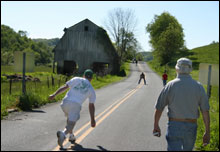
|
In a quiet West Virginia field, Mark Wilt is flat on his stomach, up to his elbows in muck. He's lost his ball, not a Titleist or Top Flite, but a steel cannonball. He rolled it down Turkey Run Road, watched it veer from the center, thud over cracks in the tar, careen across some shoulder till, and end up below a bridge in a muddy stream.
Actually, that's what the ball is supposed to do, except for the off-road detour. "Now this is dedicated road bowling," laughs John Nelson, as Mr. Wilt fishes around unsuccessfully for his ball, or "bowl," as it's called, for about 10 minutes.
The scene is hardly unusual in one of America's newest and most obscure sports - Irish road bowling - where the errant cannonballs often end up in fields, rivers, and even cow patties. These are just a few of the hazards along rural lanes where the sport is played with passion and a strange kind of precision.
| |
[more]
thanks to DANGEROUSMETA!
The Sport of Road Bowling in Ireland
West Virginia Irish Road Bowling Association
WV Irish Road Bowling "Starter Pack"

[more]
bloggus interuptus
I had great plans to finish my posts Monday but I spent the day and evening working on some websites. Then I was awakened this morning at 6am when Zoe answered a call from HomePlace where her mom is. She had fallen and was complaing of her hip hurting so she agreed that a trip to the Emergency Room was in order. We got up, got ready, and drove to the hospital in Coupeville. X-rays showed no fractures. She was able to get up and walk around a little so all was well. Her skin is very thin and it had torn on her elbow but a dressing took care of that and we drove her back to HomePlace. She was in pretty good spirits when we dropped her off.
At noon I picked up my 6 year old grandson, Mike, at his daycare and took him over to the fairgrounds in Langley where he went horse riding. There is an organization called Hope that has a program for children. There were three other kids in his session. Each kid had a horse to ride and two volunteers to help the kid. Mike signed in and put on his little crash helmet. They started off having the kid brush the horse and clean his hooves. Then the kids walked the horse, with an adult, to warm it up. There was a ramp that the kids mounted the horses from. Then two adults walked beside each horse while the kids rode. One of the adults held a rope to lead the horse but the kids had the reins and did most of the horse control. Mike is pretty excited about it. I took a lot of pictures mostly with the 85mm J9 on the Zorki 3M and the 135mm Super Takumar on the Pentax Spotmatic. At one point I had both cameras on my right wrist with wrist straps. That actually worked out pretty well. I will drop the film off in the morning.

Leaving the Truth Buried in Gaza's Sands
|
If you keep lying long enough and with enough conviction, people start to believe you -- or at least doubt the evidence in front of their own eyes. And so it has been with the Israeli army’s account of how seven members of a Palestinian family were killed, and dozens of other Palestinians injured, during shelling close by a beach in Gaza.
| |
[more]
book recommendations
Paul Butzi has some interesting comments about Linda Butler's work at The Online Photographer:
The Gentle Transition
|
Most of the time the transition from "traditional" to "digital" photography is presented as a fundamental shift, unprecedented in photographic history. I disagree—I think that the challenges and opportunities presented by digital photographic equipment are merely evolutionary.
Consider the path of one particular photographer, Linda Butler, whose work extends over decades and spans a broad range of work. Butler’s path is interesting because at each point in her work, she’s been doing what I call "following the curve" as the technology available to her improved, using the new tools to extend her reach, and to make the photographs with less botheration and hardship.
[...]
So Linda Butler has gone from an 8x10 Deardorff and HP-5 film all the way to digital capture and hybrid digital printing. For each project, she picked the tools at hand that suited to capturing the subject according to her vision. As technology evolved, she’s had new tools to choose from and she’s chosen the new tools when appropriate.
| |
[more]
I've been seeing Linda Butler's name around and was interested in her work so Paul Butzi's comments were an impetus to go online to my library's website and order the two Linda Butler books that they had.
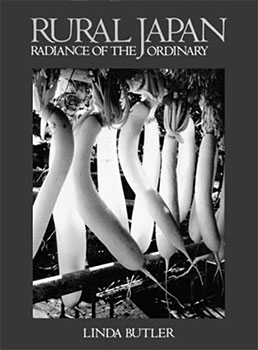
Rural Japan:
Radiance of the Ordinary
by Linda Butler
Rural Japan was of personal interest since I lived in Japan in my mid-teens during the late 1950s. We lived on the outskirts of Tokyo within an easy bicycle ride into rural Japan. I have many fond memories of the old Japan that was still there. Linda's pictures certainly qualify as pretty pictures but they are much more. She recorded a way of life that is disappearing. She also writes about her experiences in taking these pictures that adds immeasurably to the photographs. This book is out of print but used copies are available. And don't forget your library! From Barnes & Noble:
|
Taken on the islands of Honshu, Shikoku and Kyushu between 1986-1989, these exceptionally beautiful photographs capture the ``astonishing resilience'' of ancient rural customs amid the ever-increasing modernization of Japanese society. In 15 short episodes, Butler ( Inner Light: The Shaker Legacy ) tells of her experience traveling the coasts and countryside, detailing her encounters with farmers, fishermen, village people and mountain folk, some reticent, others gregarious. The text is charming and insightful, but it is the pictures that fascinate. In black and white, Butler shows us the otherworldly textures of an earthenware floor and the radiance of hanging radishes in Iwate-ken; the drizzling beauty of spring rain in Aichi-ken; the intense concentration of a Shinto priest and the eeriness of squid drying in the sun in Shimane-ken; the rippling water and stormy skies of a fishing wharf in Aomori-ken; and the camaraderie of a group of laughing gateball players in Yamagata-ken. Whether shooting a portrait or a still life, Butler uses her camera to distill the pure cultural and aesthetic essence from these rural areas.
| |
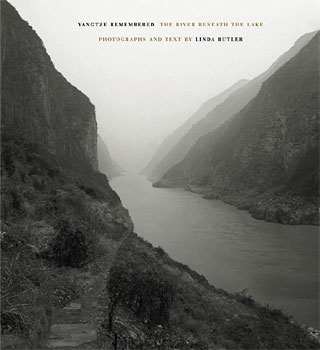
Yangtze Remembered:
The River Beneath The Lake
by Linda Butler
Yangtze Remembered is even more ambitious. From Amazon:
|
In June 2003, the Three Gorges Dam opened and a reservoir the size of lake Superior began to form, inundating 372 miles of China’s Yangtze River Valley. As 1,500 cities, towns and villages disappeared beneath the dark waters, more than a million people were being moved. Around the reservoir, huge construction projects are still transforming the landscape; mighty dikes, long bridges, apartment towers, and sprawling cities are springing up.
Between 2000 and 2003 Linda Butler made eight trips to the Yangtze to photograph the people, the human environment, and the natural landscape before, during, and after these changes. She spent long weeks in the busy cities and remote villages. Lyrical photographs of dramatic vistas are paired with images showing the ravages visited on this region by coal mining and erosion. Intimate shots of interiors reveal the contents of homes and stores, a table set for an impromptu meal, or a shop counter scattered with seed packets and posters of Mao. Informal portraits of local inhabitants preserve a record of the people as they carry pigs to market, load all their household furnishings onto a boat, or play badminton on a village street.
Accompanying the images is the photographer’s travel commentary, which reads like a dynamic series of short stories. Butler’s words reveal the invisible stories of the common people as they struggle to come to terms with the destruction of their homes and lives. Since ancient times, the Yangtze River itself has been like an unpredictable neighbor—sometimes generous, but at other times wrecking havoc on the lives of others. Perhaps because the river people have lived near such volatility they have developed a profound resilience in the face of adversity.
"Yangtze Remembered" is both a measured and a passionate book. The powerful images reveal much that we have never seen before and cannot ever see again.
| |
Powerful, indeed!
afghanistan
Revived Taliban waging 'full-blown insurgency'
|
In their biggest show of strength in nearly five years, pro-Taliban fighters are terrorizing southern Afghanistan — ambushing military patrols, assassinating opponents and even enforcing the law in remote villages where they operate with near impunity.
| |
[more]
thanks to Magpie
Aaugh!
|
This Sunday’s sacred ritual of Mass, bagels and tea with the Grumpy Old Men’s Club was rudely disrupted by the headline of the day’s Washington Post: “U.S. Airstrikes Rise In Afghanistan as Fighting Intensifies.” Great, I thought; it’s probably cheaper than funding a recruiting campaign for the Taliban and lots more effective at creating new guerrillas.
| |
[more]
thanks to Whiskey Bar
bird songs
David Attenborough: The Lyrebird
|
In April 2006, to celebrate naturalist David Attenborough's 80th birthday, the public were asked to vote on their favourite of his television moments. This clip of the lyrebird was voted number one. A Lyrebird is either of two species of ground-dwelling Australian birds, most notable for their extraordinary ability to mimic natural and artificial sounds from their environment.
| |
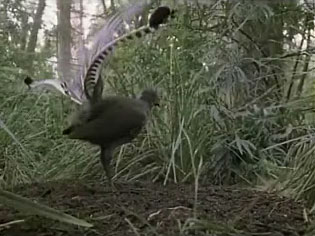
[more]
thanks to Magpie
Would your believe a chain saw?
the real evil empire
Exceptional Americans Manifest Their Destiny:
And to Hell with the Consequences...
|
Contrary to the “catapulted propaganda”, Enron, Haditha, and Abu Ghraib were not isolated incidents or the work of a “few bad apples”. American savagery and oppressive behavior pervades our society and predates our nation’s birth. Building its patriarchal wealth on the backs of Black slaves and cheap labor while acquiring its territory through Native American genocide, predatory exploitation of non-Anglos, the poor, women, and the working class emerged as a pillar of America’s socioeconomic “success” before we even declared our independence.
With the advent of the Industrial Age, transcontinental railroads, and the rapid proliferation of Capitalism, an increasingly empowered young nation with an insatiable lust for more land, resources, and profits began to seek prey beyond its borders. At the close of the Nineteenth Century, the American Eagle spread its wings as it began mimicking the rapacious behavior of its Western European ancestors.
With the sun finally preparing to set on the British Empire, the days of conquest and expansion dawned for the nascent American Empire. Pathologically hubristic notions like Manifest Destiny and American Exceptionalism served to dehumanize indigenous people to justify invasion, theft and murder as acts of necessity to bring civilization to “primitives”.
In his latest book, Overthrow , former New York Times Bureau Chief Stephen Kinzer chronicles America’s exploits as an empire and imperialist nation.
| |
[more]
I just put Kinzer's Overthrow : America's Century of Regime Change from Hawaii to Iraq on hold at my library. Should be interesting.
book recommendation
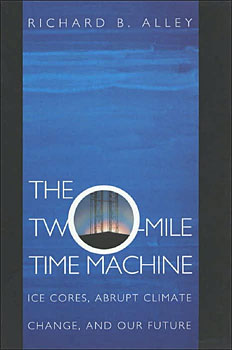
The Two-Mile Time Machine
by Richard B. Alley
From Amazon:
|
Alley, a participant in five expeditions to Greenland and three to Antarctica, well explains how the ice caps in both places record climate history, how to read those records in cylinders of bored ice, and what they reveal about changes in climate. He waits until the end to discuss the possibility of disaster, which, unfortunately, he thinks is highly likely, perhaps soon. The ice borings disclose a history of sudden changes in a continuity that is predominantly much colder than the period during which humanity has developed. Moreover, change can be triggered by "pushes" as large as continental drift or as seemingly puny as a change in the atmospheric balance of greenhouse gases. The latter can slow or stop the huge oceanic "conveyor belt" that warms the North Atlantic, and then habitable, cultivable lands shrink due to plummeting temperatures and reduced precipitation. Is doom inevitable in our time? Given current knowledge, we can't say. But proceeding as if humanity could affect climate change is only prudent. Wonderfully accessible, information-packed science reading.
| |
We would be looking at some severe changes in cimate even without global warming. We are in an abnormally stable and warm period. Then there are the changes being caused by man.
4x5 polaroid conversion
The 4x5 Polaroid conversion proceeds slowly. It was really hot this weekend so I spent some time in the basement working on it. Much cooler down there. Too hot to do anything else. It was in the mid 80s. I admit it, we're heat wimps. The last time I mentioned the Polaroid I had the lens board off.
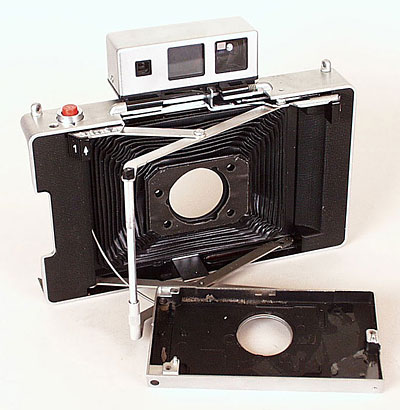
With the help of a dremel tool I cleared the top and opened the hole for the shutter and ground the surface more or less flat. Flatter, anyway. Here the shutter is put in place.
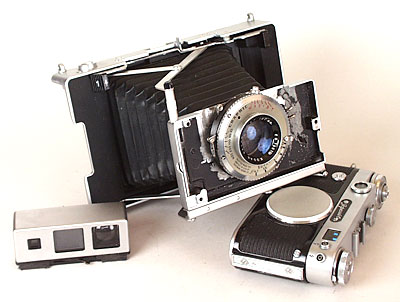
I couldn't enlarge the lensboard hole enough for the retaining ring (not enough material) for the Kodak 127 Ektar, so I'm going to have to eventually bond it in place. It's just laying in there now. Now that it's fitted, I can send it off for a CLA. Then smooth and paint the lensboard and start working on the back of the camera. I also removed the rangefinder. I will probably use some auto body bondo to mount the shutter on the lensboard. I think it can be popped loose if I need to. I hope.
free nations
Reader David Iles sent the following comments:
|
During a speech on the war on terror (October 6, 2005) bush said:
When 25 Iraqi children are killed in a bombing, or Iraqi teachers are executed at their school, or hospital workers are killed caring for the wounded, this is murder, pure and simple -- the total rejection of justice and honor and morality and religion.
Later during a question and answer session bush said:
THE PRESIDENT: How many Iraqi citizens have died in this war? I would say 30,000, more or less, have died as a result of
the initial incursion and the ongoing violence against Iraqis
The white house has this posted on their website at:
http://www.whitehouse.gov/news/releases/2005/10/20051006-3.html
Just an additional note, bush said:
Free nations are peaceful nations. Free nations don't attack each other. Free nations don't develop weapons of mass
destruction
As the worlds largest holders and most vigorous creators of more weapons of mass destruction, and as the nation that has attacked more countries in the world than any other in the last ten (50) years. And as the country that accounts for over half of the worlds military spending and is the worlds largest exporter of weapons and military training, by president bushs own definition we are not and can never be a free nation as long as we continue the military practices that he and our congressman and senators promote.
| |
|
|
|
|










